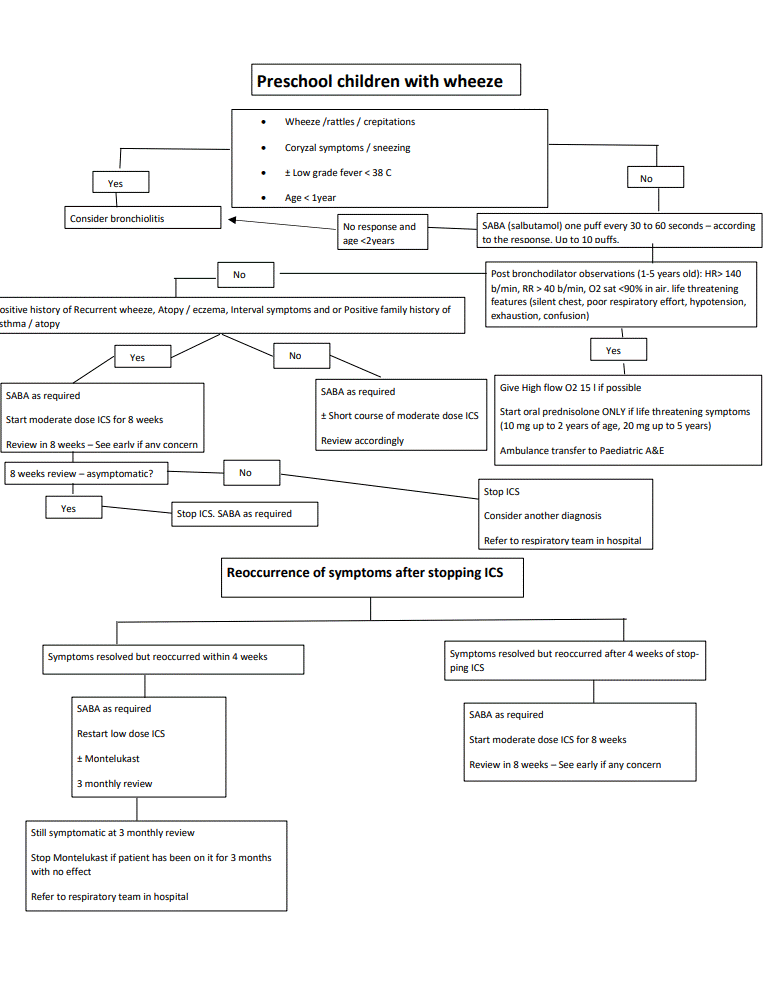Preschool Wheeze
Definition/Description
Wheeze can be defined as a continuous high-pitched sound, with musical quality, emitting from the chest during expiration.
Incidence of preschool wheeze has significantly increased in the UK. One in three children has at least one episode of wheezing prior to their third birthday. The care of preschool viral wheeze represents 0.15% of the total budget of the UK National Health Services. Furthermore, estimates of the costs to society of caring for preschool children who attended hospital for viral wheeze, are up to £2.6 million.
Education (both to self as well as to the patient) is an essential part of Asthma / wheeze management for all age groups at all levels of health care provision.
Smoking and Wheeze
Parental smoking has an important impact on asthma and wheezing illnesses in infants and children. In utero exposure is associated with impaired lung growth and wheezing illnesses, particularly in pre-school children. Children who are exposed to cigarette smoke and have tendency to wheeze have increased wheezing symptoms, more frequent use of their medicines and more frequent hospitalisation.
Red Flag Symptoms
- Worsening work of breathing (for example grunting, nasal flaring, marked chest recession).
- PERSISTENT oxygen saturation of less than 92% when breathing in room air.
- Fluid intake 50–75% of normal or no wet nappy for 12 hours
- Apnoea or cyanosis
- Exhaustion (for example, not responding normally to social cues, wakes only with prolonged stimulation).
Guidelines on Management
Acute Treatment
Short Acting Beta2 Agonist (SABA)
Inhalation of short-acting beta2 agonist (SABA) is the key to acute treatment of childhood wheezing disorders. Prescribing SABA should to be tailored according to the individual patient’s requirement within the maximum dosage of up to 10 puffs every 4 hours. One puff should be given every 30–60 seconds, according to response, up to a maximum of ten puffs. All children should be referred to hospital if they require more than 10 puffs and earlier than 4 hours. However, they should be managed in the community if they are requiring less than 10 puffs with intervals of 4 hours or more than 4 hours to control their symptoms, in the absence of any red flags (see above).
Wheezy Preschool Children
Montelukast
Montelukast reduces the severity of symptoms in some wheezy preschool children. However, there is limited data to support the use of oral Montelukast in acute management. Therefore, it should be used only on individual basis.
Oral Corticosteroids
The administration of prednisolone to pre-schoolers without atopy who have episodic wheezing is not recommended unless wheezing is severe enough to require admission to an intensive care unit. DO NOT GIVE PREDNISOLONE IN THE COMMUNITY UNLESS THERE ARE LIFE THREATENING SYMPTOMS.
Prophylactic medications
The evidence for use of prophylactic medications depends on the type of the patient. Does the patient have episodic Viral Induced Wheeze (VIW) or Multi-Trigger Wheeze (MTW)?
Episodic Viral Induced Wheeze is defined as wheeze in discrete episodes, with the child being well between episodes, and is usually diagnosed in children who wheeze only in the presence of coryzal symptoms.
Multiple trigger wheeze is defined as wheezing that shows discrete exacerbations but also have symptoms in between episodes. As the name implies, wheeze is triggered by factors other than just viruses i.e. mist, crying, laughter, exercise, smoke or allergens. MTW is therefore diagnosed in children who wheeze in the presence and absence of coryzal symptoms. There is often a positive personal or family history of atopy.
Inhaled Corticosteroids (ICS)
There is no role of ICS in mild to moderate cases of VIW. Moderate to high dose ICS used intermittently are effective in children with frequent episodes of moderately severe episodic VIW or MTW. However, it is associated with short term effects on growth and cannot be recommended as a routine treatment. (please see doses below)
Maintenance low dose ICS is recommended for MTW only. ICS should be stopped if symptoms don’t improve (after 8 weeks) and treatment breaks should be employed (usually after 3 months) to see if the symptoms have resolved or continuous therapy is still required.
Montelukast
There is little evidence in the support of any prophylactic medications in cases of VIW. However, Montelukast can be the first line preventer therapy for the children with frequent episodes of VIW and children with MTW. A short trial of Montelukast can be extended to maintenance if it is required especially in winter months.
Nasal Corticosteroids
There is no evidence of a difference in the severity of nocturnal symptoms, daytime symptoms, activity or total scores during episodes, so it is not recommended.
Long Acting Beta2 Agonist (LABA)
Long acting beta2 agonists (LABA) are not licensed in the under-5s. LABA, when used in the absence of inhaled steroids, are implicated in abrupt, severe asthma exacerbations and asthma-related deaths.
First follow up after discharge
Children should be seen in primary care within one week (ideally within 3 days) after discharge from hospital.
- To make sure their symptoms are resolving
- To adjust the dose of SABA if they are still symptomatic/ completely asymptomatic
- For review of inhaler technique- carers should be confident in using their child’s inhaler with the spacer devices
- To emphasize that carers should ensure their child’s inhaler and spacer device is always with the child
- To discuss warning symptoms
- To arrange the next follow up
- To reiterate smoking cessation advice if required
Referral Criteria/Information
No Referral Criteria/Information
Additional Resources & Reference
Associated Policies
Specialties
Places covered by
- East Riding
- Hull
Hospital Trusts
- Hull University Teaching Hospitals
